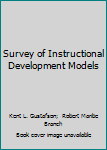Survey of Instructional Development Models
Select Format
Select Condition 
Book Overview
No Synopsis Available.
Format:Paperback
Language:English
ISBN:0937597554
ISBN13:9780937597552
Release Date:January 2002
Publisher:Eric Clearinghouse on Information
Weight:0.40 lbs.
Dimensions:8.8" x 0.3" x 5.8"
Customer Reviews
1 rating
A great starting point and catalyst for ID research!
Published by Thriftbooks.com User , 25 years ago
Tooling Up!A review of "Survey of Instructional Development Models", Gustafson & Branch, Eric Clearinghouse on Information & Technology, Syracuse University, 1997.It's time to open your toolbox, organise and restock! The authors of this book liken Instructional Design models to the ID professional's `tools', where one needs to have the `right tool for the right job'. In order to do this, the authors offer a review of the historical trends in model development and a discussion of their roles and context in the marketplace- or should we say hardware store! To help you maintain your repertoire of tools, the authors present a matrix to help you classify the plethora of models available for use. I enjoyed reading this book because I found it a great starting point and catalyst into the research of Instructional Design and development. It is presented clearly and concisely, without too much detail to get bogged down under, yet enough information to be used as a quick reference or to whet the appetite. I often found myself searching for the original publications about models, wanting more information and detail.I compared Gustafson and Branch's matrix to one from Edmonds, Branch and Mukherjee(1). The approach from the latter appears more relevant for categorising the different levels of ID occurring in today's present context. However, the reader may struggle with the level of detail involved. I would suggest the Edwards et al. model should be studied once the reader is more familiar with the Instructional Design and development process. Gustafson and Branch's matrix stands as an easy to follow classification that helps to quickly determine the general context of a design and development process and find the relevant models to choose from- or vice versa. The authors also present examples of models in each classification which helps to clarify the application of the matrix.The book finishes with a very interesting discussion of the scientific validation of models, how the instructional designer can use these models in the workplace and what the future may hold in the instructional development process.Overall, despite this book being a how- to -of - how- tos, I would recommend it highly for students of instructional technology, as well as for those in the field needing a good source of reference in the use of instructional models. So get tooling!(1) Edmonds, G., Branch, R., & Mukherjee, P. (1994). A conceptual framework for comparing instructional design models. Educational Technology Research and Development, 42(4), 55-62. (EJ 496 612)






